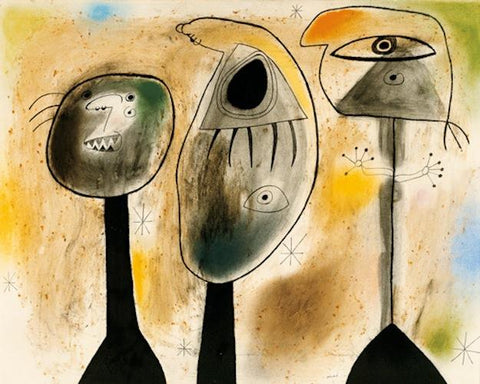An unconditional fan of Joan Miró, I suggest a stroll through his work. But Miró's work is so vast that I present it in several articles. Here I offer, chronologically, my favorites among his creations between 1930 and 1950.
1930

In the 1930s, the surrealist movement spread to all areas, commerce, advertising, fashion, theater, literature or design... For André Breton and Louis Aragon, this rapprochement with commercial activities is contrary to the very principles of the movement, hence many conflicts with members. Joan Miró sees new creative possibilities in these connections with surrealism. In addition to designing theater sets, sets and costumes, Miró became involved in the decorative arts.
This painting, soberly titled "Painting", 1933, is one of four tapestry projects commissioned in 1933 by the French collector Marie Cuttoli.
I love the woman on the right, disheveled and with well-defined breasts!

Joan Miró, “Figure”, 1932.

Joan Miró, “The Bather”, 1932.
1933

Joan Miró, “Composition (Small Universe)”, 1933.
1934
Stencil for "Cahier d'Art", the famous surrealist art magazine directed by Chrisitan Zervos, 1934. It was still fantastic when often confidential magazines included original creations in litho, stencils and even engravings. It was important for artists to rub shoulders with writers, poets, philosophers. Today, the choice is quickly made by artists between a small confidential magazine and an article in a celebrity magazine. Everyone wants immediate notoriety.
1936
And people ask me why I am sometimes critical of certain installations by contemporary artists. When we have historical works in mind, the gaze becomes demanding. Joan Miró, “Object”, 1936. Yes yes, Miró and 1936, more than 80 years ago.
1937
This poster expresses Miró's hatred towards the Franco movement, which is probably what decided him to create this poster for the 1937 international exhibition in Paris.
"The horrible tragedy we are going through can shake isolated geniuses and give them increased vigor. May the powers of regression known as 'fascism' spread, may they plunge us a little further into the impasse of cruelty and incomprehension, and all human dignity is over."
Joan Miró, Cahiers d’art, Paris.
1938
A beautiful blue for walking with Miró, "Birds and Insects", 1938.
Totally surreal! “Group of Characters” by Joan Miró, 1938.
Joan Miró, “Characters”, 1938.
1940
Joan Miró, "The Morning Star", 1940, from the series "Constellations", works grouped under this term during the exhibition at the Pierre Matisse gallery in New York in 1945. The series was started in Varengeville, in Normandy, end of 1939, when Miró was staying near his friend George Braque.
Pierre Matisse, son of the famous painter and sculptor, had one of the best galleries in New York, exhibiting Miró and Giacometti among others.
1941
Miró, “Number and constellations in love with a woman”. On closer inspection, it’s still very sexual!
1942
Joan Miró, “Women before the sun”, 1942.
Painted on November 23, 1942, these “Characters in the Night” by Miró have remained dashing.
1944
Miró, “Women and birds in the night”, 1944.
1947
The simple happiness of a kind Miró.
A page from "Parler Seul", a fantastic book bringing together a poetic text by Tristan Tzara written during a stay at the Saint-Alban psychiatric hospital in 1945 and 70 original lithographs by Joan Miró.
In 1947, my grandfather, who had just opened his gallery in Paris, had the audacity to launch into the publication of what would become one of the greatest masterpieces of his Catalan friend.
However, at the time Grandpa did not have great financial means, but his passion for litho undoubtedly carried him through. It will take two years to print all 253 copies!
Joan Miró, "Women and Birds in the Night", completed May 5, 1947.
This is the first collaboration between Joan Miró and Aimé Maeght.
My grandfather, for this huge exhibition organized with Marcel Duchamp and André Breton, in 1947, asked Miró to make an original lithograph poster. The artist will never leave the Maeght Gallery again and will publish with Maeght Editeur more than 2,000 engravings, lithos, posters, books...
Joan Miró, 1947, year in which he participated in the "International Exhibition on Surrealism" at the Maeght gallery.
1948
Miró, “Acrobat in the Night Garden”, 1948.
When I was little, I spent hours counting and recounting the points and the stars.
1949
To dream a little longer. Joan Miro, 1949.
1950
Joan Miró, "Character and Stars", 1950. The simplicity of a litho, a few colors, very black lines, Miró was truly an artist who knew how to sublimate techniques.
The question can be read in the look of Joan Miró in this photo by Michel Sima, taken in 1950.
Find a thousand anecdotes about the Maeght adventure in my
book The Maeght Saga, you can receive it with a dedication
here
blmir


























